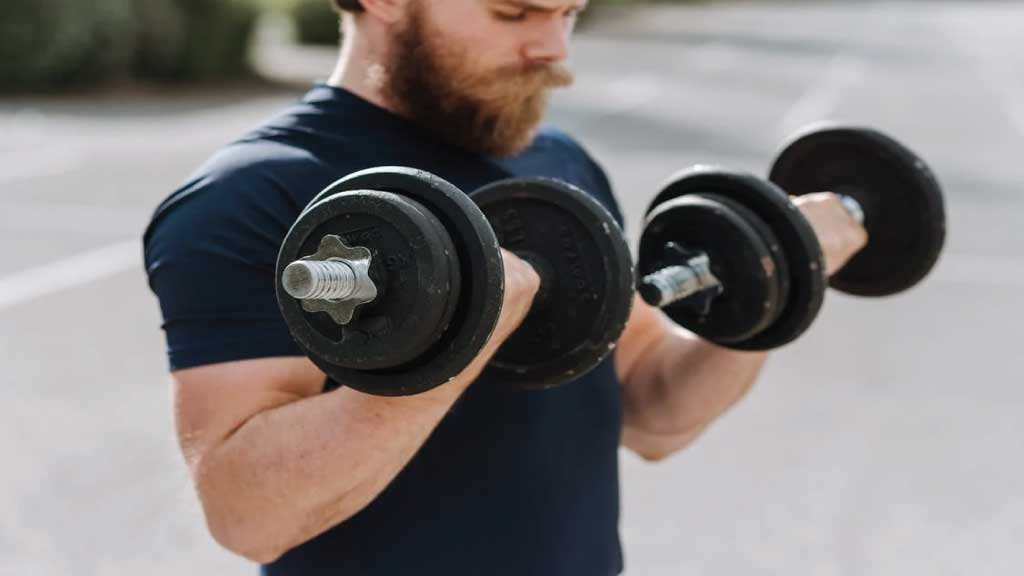In the pursuit of sculpted arms and enhanced strength, incorporating a dumbbell workout regimen tailored for triceps and biceps is paramount. These muscle groups play a pivotal role in various upper body movements, from lifting to pushing. However, achieving optimal results requires strategic exercises that target and challenge these specific areas effectively. Here, we present the ultimate dumbbell workout meticulously crafted to elevate your triceps and biceps to new heights of strength and definition.
Understanding the Anatomy
Before delving into the workout routine, it’s essential to grasp the anatomy of the triceps and biceps. The triceps brachii comprises three heads: the long head, lateral head, and medial head, located at the back of the upper arm. Conversely, the biceps brachii consists of two heads: the long head and short head, situated at the front of the upper arm. Each muscle group serves distinct functions, contributing to arm flexion and extension.
Warm-Up: Preparing for Peak Performance
To optimize your workout and prevent injury, begin with a dynamic warm-up session. Dynamic stretching exercises such as arm circles, shoulder rolls, and wrist rotations increase blood flow to the muscles, enhancing flexibility and range of motion. Perform each movement for 10-15 repetitions to activate the triceps and biceps and prepare them for the upcoming intensity.
The Ultimate Dumbbell Workout Routine
1. Dumbbell Bicep Curls
- Muscles Targeted: Biceps (Long Head, Short Head)
- Execution: Stand tall with a dumbbell in each hand, palms facing forward. Keep your elbows close to your body and slowly curl the weights towards your shoulders, contracting the biceps. Lower the dumbbells in a controlled manner and repeat for 3 sets of 12-15 repetitions.
2. Tricep Dumbbell Kickbacks
- Muscles Targeted: Triceps (Lateral Head, Medial Head)
- Execution: Hold a dumbbell in each hand and hinge forward from the hips, maintaining a flat back. Extend your arms behind you, fully straightening them while contracting the triceps. Slowly return to the starting position and repeat for 3 sets of 12-15 repetitions.
3. Hammer Curls
- Muscles Targeted: Biceps (Brachialis)
- Execution: Hold a dumbbell in each hand, palms facing inward towards your body. Keep your elbows close to your sides and curl the weights towards your shoulders, emphasizing the brachialis muscle. Lower the dumbbells under control and repeat for 3 sets of 12-15 repetitions.
4. Overhead Dumbbell Tricep Extension
- Muscles Targeted: Triceps (Long Head)
- Execution: Sit on a bench or stand upright with a dumbbell held overhead with both hands. Lower the weight behind your head, bending at the elbows until your forearms are parallel to the floor. Extend your arms to raise the dumbbell back to the starting position and repeat for 3 sets of 12-15 repetitions.
5. Concentration Curls
- Muscles Targeted: Biceps (Brachialis, Brachioradialis)
- Execution: Sit on a bench with your legs spread apart. Hold a dumbbell in one hand, allowing it to hang between your legs. Curl the weight towards your shoulder while keeping your upper arm stationary. Lower the dumbbell with control and repeat for 3 sets of 12-15 repetitions on each arm.
Maximizing Results: Tips for Success
- Progressive Overload: Continuously challenge your muscles by increasing the weight or repetitions as your strength improves.
- Proper Form: Maintain proper technique throughout each exercise to maximize muscle engagement and reduce the risk of injury.
- Rest and Recovery: Allow adequate rest between sets and incorporate rest days into your workout schedule to facilitate muscle repair and growth.
- Nutrition: Fuel your body with a balanced diet rich in protein, complex carbohydrates, and healthy fats to support muscle development and recovery.
Advanced Techniques for Enhanced Muscle Activation

1. Supersetting: Maximizing Efficiency
Incorporate supersets into your dumbbell workout routine to enhance muscle activation and efficiency. Supersetting involves performing two exercises back-to-back with minimal rest in between. Pair complementary exercises targeting triceps and biceps to maximize the pump and stimulate muscle growth. For example, pair tricep kickbacks with bicep curls or overhead tricep extensions with hammer curls. This technique not only saves time but also keeps your muscles engaged throughout the workout, leading to greater gains.
2. Tempo Training: Controlling the Contraction
Manipulate the tempo of your repetitions to increase time under tension and optimize muscle recruitment. Experiment with slower eccentric (lowering) and concentric (lifting) phases to intensify the workout. For instance, perform a 3-second descent during bicep curls and a 2-second ascent for a more controlled movement. This deliberate approach forces your muscles to work harder throughout each rep, resulting in greater muscle activation and growth.
3. Isometric Holds: Building Strength and Stability
Incorporate isometric holds into your dumbbell exercises to build strength and stability in the triceps and biceps. Pause at the midpoint or peak contraction of each movement and hold for 2-3 seconds before completing the repetition. Isometric contractions engage more muscle fibers and improve muscular endurance, leading to enhanced performance and definition. Experiment with isometric holds during exercises like concentration curls and tricep overhead extensions to amplify the intensity and sculpt your arms effectively.
4. Drop Sets: Pushing Past Plateaus
Integrate drop sets into your workout regimen to push past plateaus and stimulate muscle growth. Start with a challenging weight for the desired number of repetitions, then immediately decrease the weight and continue the set until failure. This technique exhausts the muscle fibers and induces metabolic stress, promoting hypertrophy and strength gains. Incorporate drop sets into exercises like bicep curls and tricep kickbacks to shock your muscles and ignite new growth.
5. Mind-Muscle Connection: Focusing on Form and Feel
Develop a strong mind-muscle connection during your dumbbell workout to optimize muscle engagement and contraction. Focus on the target muscles throughout each exercise, visualizing them contracting and lengthening with each repetition. Emphasize proper form and technique, ensuring a full range of motion and maximum muscle recruitment. By honing this connection, you can enhance the effectiveness of your workout and achieve superior results in triceps and biceps development.
Elevate Your Dumbbell Workout for Optimal Results
Incorporating advanced techniques such as supersets, tempo training, isometric holds, drop sets, and mind-muscle connection into your dumbbell workout routine can elevate your results to new heights. By challenging your muscles in innovative ways and prioritizing proper form and intensity, you can sculpt stronger, more defined triceps and biceps. Stay consistent, listen to your body, and continually strive for improvement to achieve your fitness goals.
Maximizing Recovery for Optimal Muscle Growth
1. Importance of Rest Days: Allowing Muscles to Repair
Incorporating rest days into your workout schedule is crucial for optimal muscle growth and recovery. During intense resistance training, micro-tears occur in the triceps and biceps muscles. Rest days allow these muscles to repair and rebuild stronger than before, leading to hypertrophy and increased strength. Aim for at least one or two rest days per week to prevent overtraining and promote optimal recovery.
2. Proper Nutrition: Fueling Muscle Repair and Growth
Nutrition plays a pivotal role in muscle recovery and growth. Ensure you’re consuming an adequate amount of protein to support muscle repair and synthesis. Lean protein sources such as chicken, fish, eggs, and tofu are ideal choices. Additionally, include complex carbohydrates to replenish glycogen stores and provide sustained energy for workouts. Incorporate healthy fats and a variety of fruits and vegetables to support overall health and recovery.
3. Hydration: Maintaining Optimal Performance
Staying hydrated is essential for muscle recovery and overall performance. Dehydration can impair muscle function and hinder recovery processes. Aim to drink plenty of water throughout the day, especially before, during, and after your workouts. Hydration supports nutrient delivery to the muscles and helps flush out metabolic waste products, promoting faster recovery and reducing the risk of injury.
4. Sleep Quality: Maximizing Growth Hormone Release
Quality sleep is critical for muscle recovery and growth. During sleep, the body releases growth hormone, which aids in tissue repair and regeneration. Aim for 7-9 hours of uninterrupted sleep each night to optimize recovery and maximize muscle gains. Create a conducive sleep environment by minimizing exposure to screens, maintaining a consistent sleep schedule, and practicing relaxation techniques before bed.
5. Active Recovery: Enhancing Circulation and Mobility
Incorporate active recovery techniques into your routine to enhance circulation and mobility in the triceps and biceps. Light cardio activities such as walking, cycling, or swimming can help flush out metabolic by-products and reduce muscle soreness. Additionally, incorporate stretching exercises to improve flexibility and prevent stiffness. Active recovery sessions promote faster recovery between workouts and contribute to overall muscle health.
Related Posts:
Push Day Workout Routine Guide: Conquer Your Push Day
High Intensity Interval Training Workouts: Energize Your Fitness
10 Best Fitness Challenge Ideas at Home
Conclusion
Incorporating a targeted dumbbell workout for triceps and biceps into your fitness routine can yield significant gains in strength, size, and definition. By understanding the anatomy of these muscle groups and implementing a structured exercise regimen, you can sculpt your arms to perfection. Remember to prioritize proper form, progressive overload, and adequate rest to optimize your results and achieve your fitness goals.
Frequently Asked Questions (FAQs) About Dumbbell Workout for Triceps and Biceps
What are the benefits of incorporating dumbbell exercises for triceps and biceps?
Dumbbell exercises offer numerous benefits, including increased muscle strength, size, and definition in the triceps and biceps. They also improve muscular endurance, stability, and balance. Additionally, dumbbell workouts allow for unilateral training, addressing muscle imbalances and enhancing functional strength for everyday activities.
Can beginners perform dumbbell exercises for triceps and biceps?
Yes, beginners can safely incorporate dumbbell exercises into their workout routines. Start with lighter weights and focus on mastering proper form and technique before progressing to heavier loads. Begin with basic exercises such as bicep curls and tricep kickbacks, gradually increasing intensity and complexity as strength and proficiency improve.
How often should I perform a dumbbell workout for triceps and biceps?
Ideally, aim to train the triceps and biceps 2-3 times per week, with at least one rest day in between sessions to allow for adequate recovery. Consistency is key to seeing results, so stick to a regular workout schedule and gradually increase the intensity and volume over time to continue challenging your muscles.
Can I combine dumbbell exercises with other forms of resistance training?
Yes, you can incorporate dumbbell exercises into a comprehensive resistance training program that includes other equipment such as barbells, resistance bands, or bodyweight exercises. Combining different forms of resistance training allows for greater muscle stimulation and variety in your workouts, leading to more significant gains in strength, size, and overall fitness.
How can I prevent injury while performing dumbbell exercises for triceps and biceps?
To minimize the risk of injury during dumbbell workouts, prioritize proper form and technique throughout each exercise. Start with lighter weights to familiarize yourself with the movements and gradually increase resistance as you become more confident and proficient. Warm up adequately before each workout, and listen to your body’s signals to avoid overexertion or strain. If you experience any discomfort or pain, stop the exercise immediately and seek guidance from a qualified fitness professional.

